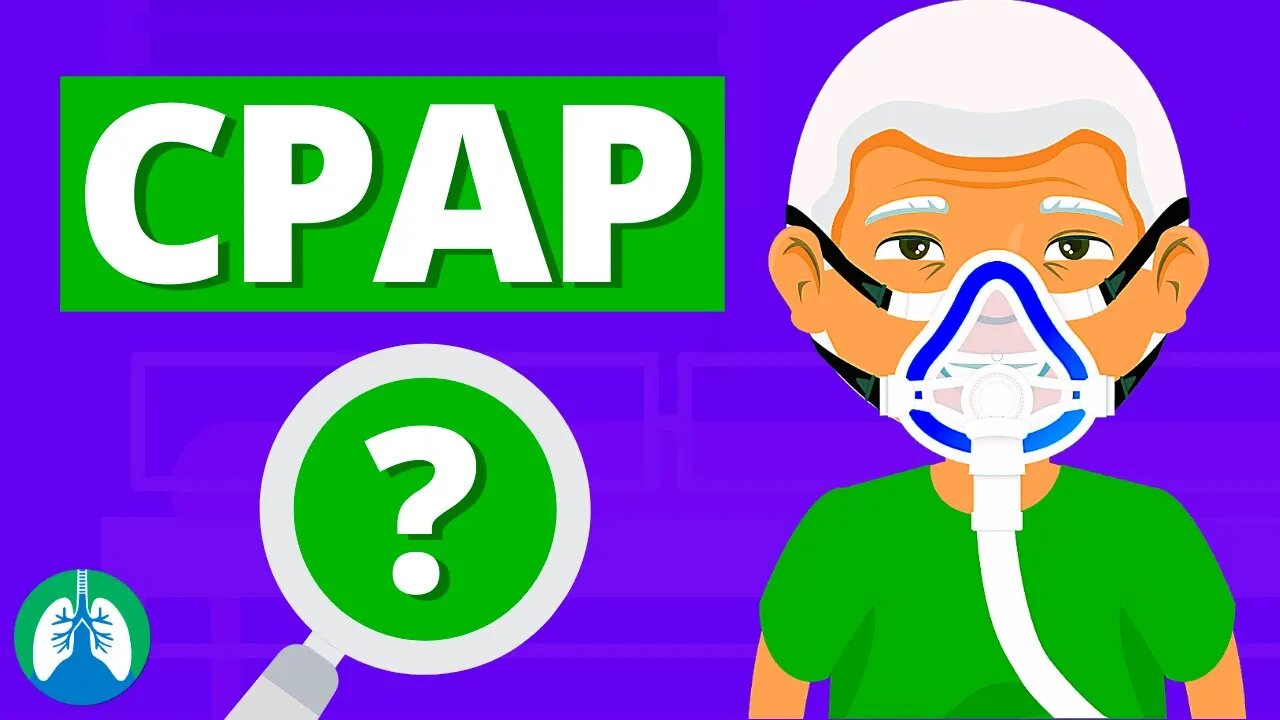Premium Only Content

What is CPAP? (Continuous Positive Airway Pressure) | Respiratory Therapy Zone
What is CPAP? This video will teach you all about Continuous Positive Airway Pressure!
💥Full Guide on CPAP ➜ ➜ ➜ https://bit.ly/2Ste6Ms
➡️ What is CPAP?
Before we get deeper into the content, one important thing to remember about CPAP is that it can only be delivered if the patient is breathing spontaneously because it does not provide any mechanical breaths.
➡️ So go ahead and engrave that into your memory:
Never administer or recommend CPAP for a patient who is not breathing spontaneously.
In general, noninvasive ventilation delivers an inspiratory pressure (IPAP) and an expiratory pressure (EPAP), but CPAP is active when both pressures are equal. Because if you think about it, that's where CPAP gets its name — Continuous Positive Airway Pressure — because a continuous pressure is being delivered throughout both the inspiratory and expiratory phase of breathing.
The primary indication for CPAP is: Obstructive Sleep Apnea
Obstructive Sleep Apnea (OSA) is a condition where the patient has five episodes of apnea that last at least 10 seconds each within a one-hour time period while asleep. This type of sleep apnea is caused by an airflow obstruction that occurs along with continuous breathing efforts by the patient. But for now, just know that patients can wear a CPAP mask at night while asleep and the continuous positive airway pressure that is applied helps to decrease the apnea episodes by keeping the airway open to overcome the obstruction.
➡️ Contraindications for CPAP:
Apnea
Hypoventilation
Respiratory muscle fatigue
Facial burns or trauma
Claustrophobia
➡️ CPAP in Traditional Mechanical Ventilation
CPAP can be delivered as a spontaneous breathing mode is traditional mechanical ventilation and is commonly used along with Pressure Support when attempts are made to wean a patient from the ventilator. When the CPAP mode is in use, the patient must be monitored carefully for fatigue because they are the one that is doing all the work. Since it is a spontaneous mode, the machine will not deliver any breaths. It just provides a continuous pressure that helps supports the patient's own breathing cycle. But the machine does not contribute to the minute ventilation. That is all done by the patient.
➡️ So for patients who are receiving CPAP, you should monitor them for signs of fatigue, which are:
Dyspnea
Tachycardia
Increasing PaCO2 level
Increasing respiratory rate
Decreasing tidal volume or vital capacity
Decreasing MIP
In these cases, you would most likely be able to tell that the patient is working harder than normal to breathe and you'd likely notice some usage of the accessory muscles of breathing, which is a sign of respiratory distress. When these signs are present, the patient should be switched from CPAP back to a conventional mode of ventilation.
Which, we do have a full video and study guide on, if you're interested, I'll drop links down below in the description.
💥Full Guide on CPAP ➜ ➜ ➜ https://bit.ly/2Ste6Ms
—————
📗 BEST STUDY GUIDES FOR YOU
▪ TMC Test Bank 👉 http://bit.ly/2IGeqSu
▪ Hacking the TMC Exam 👉 http://bit.ly/2XBc8do
▪ TMC Exam Bundle (Save $) 👉 https://bit.ly/34pqEsV
▪ Daily TMC Practice Questions 👉 http://bit.ly/2NnXh3C
💙MORE FROM RTZ
▪ Free TMC Practice Exam 👉 http://bit.ly/2XlwASL
▪ Free RRT Cheat Sheet 👉 http://bit.ly/2IbmOKB
▪ Resources for RT's 👉 http://bit.ly/2WVV5qo
▪ Testimonials 👉 http://bit.ly/2x7b5Gl
🌐FOLLOW US
▪ Instagram 👉 http://bit.ly/2FhF0jV
▪ Twitter 👉 http://bit.ly/2ZsS6T1
▪ Facebook 👉 http://bit.ly/2MSEejt
▪ Pinterest 👉 http://bit.ly/2ZwVLPw
🚑MEDICAL DISCLAIMER
Medicine and Respiratory Therapy are continuously changing practices. The information in this video is for educational and entertainment purposes only. For medical advice, please consult with a physician or qualified medical professional.
💡AFFILIATE DISCLAIMER
This description contains affiliate links. If you decide to purchase a product through one of them, we receive a small commission at no cost to you.
—————
⏰TIMESTAMPS
0:00 - Intro
0:33 - What is CPAP?
1:22 - Primary indication for CPAP
1:28 - Obstructive Sleep Apnea (OSA)
2:11 - Contraindications for CPAP
2:32 - CPAP in Traditional Mechanical Ventilation
3:21 - Signs of Fatigue
—————
🖼CREDIT FOR MUSIC AND GRAPHICS:
▪ Music provided by NoCopyrightSounds.
▪ Check It Out: http://bit.ly/2WtPq7h
▪ Graphics: www.canva.com
▪ Graphics: www.freevector.com
▪ Graphics: www.vecteezy.com
▪ Graphics: www.pngtree.com
▪ Graphics: www.freepik.com
#RespiratoryTherapy #RespiratoryTherapist #RespiratoryTherapySchool
-
 3:17
3:17
Respiratory Therapy Zone
1 year agoWhat is Silicosis? (EXPLAINED) 🫁
444 -
 3:48:30
3:48:30
Akademiks
12 hours agoDay 1/30. Lebron checks stephen a Smith. TOry Lanez talking CRAZY asf. Lil Ronnie K*Ilers Caught
85K4 -
 3:47:54
3:47:54
I_Came_With_Fire_Podcast
16 hours agoDEPARTMENT OF EDUCATION AXED | GAZA ULTIMATUM
66.1K18 -
 2:16:53
2:16:53
FreshandFit
12 hours agoCall-In Show
92.6K12 -
 4:27:46
4:27:46
Nerdrotic
17 hours ago $58.86 earnedDaredevil Born Again REVIEW, Harry Potter Show DOA, DC HACKED! | Friday Night Tights 344 Paul Chato
175K52 -
 1:15:15
1:15:15
Glenn Greenwald
13 hours agoWeek in Review: Lee Fang and Leighton Woodhouse on Ukraine War and NYT Piece Revealing Tensions within Trump Admin; PLUS: Lee Fang Takes Audience Questions on DOGE and Big Tech | SYSTEM UPDATE #420
110K54 -
 1:03:30
1:03:30
Sarah Westall
16 hours agoMassive Government Overhaul: FBI, CIA, IRS and more to be Gutted w/ Sam Anthony
110K32 -
 1:07:40
1:07:40
IsaacButterfield
16 hours ago $5.61 earnedAustralia Under Attack | Trump's State of the Union | All LGBTQ Cast (W Guest Frenchy)
60.9K15 -
 1:23:37
1:23:37
Edge of Wonder
16 hours agoIs Your Car Collecting Your Biodata? Whistleblower Exposes Dark Agenda
55.3K13 -
 2:08:50
2:08:50
Quite Frankly
18 hours ago"A Rat at HHS, Gene Hackman, Musical Extras" ft. J Gulinello 3/7/25
55K15